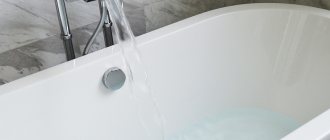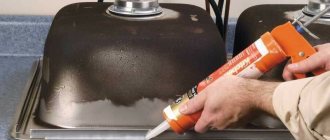Sooner or later, every apartment owner encounters the aging of the bathtub, the appearance of rusty spots, chips or scratches on it. However, not everyone will decide to replace an outdated bathtub. After all, this will cause a lot of trouble not only in terms of repairs, but also financially require large expenses. But even a non-specialist can restore a bathtub using aerosol enamel in a can. And it costs an order of magnitude less money. How to use it, read our article and watch the video. Additionally, read some reviews.
How to choose the right bath paint?
To decide what to paint the bathtub with, you need to assess the extent of its damage. If there are deep chips or cracks, then first you need to carry out preparatory work so that after priming the surface becomes smooth, and then apply thick paint. If there are no significant flaws, and the bath has simply lost its shine, this means that it was not cared for correctly, the surface was damaged by acids and alkalis. In this case, you can restore the bathtub using spray paint.
What is aerosol enamel used for?
Enamel, sold in aerosol cans, is a quick-drying paint, usually white, with a high degree of adhesion to any enamel coating. It is widely used for restoration work and coating of bathtubs, refrigerators, sinks, boilers, speakers and many other household items that have an enamel coating.
Thanks to the presence of an aerosol, the enamel is easily applied to a scratched surface; you just need to shake the can well before applying. It provides a durable coating layer that is sufficiently resistant to temperatures up to 100 degrees.
Attention! The optimal temperature for restoration work is +15-25 degrees. By maintaining the optimal temperature, aerosol enamel gains the necessary properties after 48 hours.
Advantages and disadvantages of bath enamel in cans
The paint in cans dries quickly, adheres well to the enamel coating, and is easy to apply. Shake the can before application; the paint does not need to be mixed with hardeners.
Advantages of spray paint:
- application is quick and easy, no additional tools are required;
- enamel dries very quickly;
- the material fits well, the surface becomes smooth;
- spray paint has different colors and shades;
- These products can be used to cover bathtubs made of steel and cast iron.
This type of material also has its disadvantages:
- different colors are not mixed to obtain the desired shade;
- If the application is incorrect, smudges or sagging may appear.
Types of aerosol paints
The modern market offers a large selection of aerosol enamels for baths and ceramics. Almost every manufacturer tries to produce bath paint in several formats, including aerosols or sprays.
Spray paint WHITEST New Ton
Aerosol New Ton is a Ukrainian epoxy-based bath enamel. The paint dries quickly and has excellent adhesion to enamel surfaces, which is especially necessary for restoration, for example, of an old cast-iron bathtub. The enamel is presented only in snow-white form. The volume of the can is 400 ml. Shelf life: 3 years. Cost – from 200 rubles per can.
It is important that New Ton provides a reliable coating with resistance to temperatures up to 100 degrees. The enamel does not peel off or crack. There is no need to prime the surface before applying New Ton. One layer dries in 6 hours, a completely multi-layer coating will dry in two days.
Enamel spray for baths and ceramics Kudo
Aerosol for baths and ceramics Kudo is a Russian alkyd-based enamel. Quick drying (no more than 5 hours), excellent adhesion to various materials made this paint very popular. Other positive qualities include temperature resistance and high hiding power. The shelf life is 5 years, and you will have to pay a little more than 200 rubles for a can.
Color – white – can volume 520 ml. This is enough to treat about 2 square meters of surface (in one layer). Dry for 10-15 minutes between coats. Complete drying of the treated surface is achieved after 24 hours. You can use the bath for its intended purpose after three days.
Basic rules for applying bath enamel in cans
Before starting the main work, the bathtub must be cleaned, then sanded, and degreased with a solvent. The can of enamel must be shaken well and rough sprayed so that the stream flows evenly. During painting, the can of enamel must be held strictly vertically; spraying is carried out at a distance of 30 centimeters in a thin layer. There should be no bubbles or smudges on the surface, otherwise the enamel in these places will peel off after drying. To ensure a high-quality surface, the enamel must be applied in a thin layer several times. If the enamel is partially used, then the container is turned with the valve down, and then sprayed until the stream becomes discolored. Thus, the can can be used several times. Since the aerosol can for painting a bathtub has a certain pressure, you should not leave it in a place where there will be direct exposure to the sun. Do not store the cylinder at temperatures above 50 degrees, and do not use it near an open fire. After use, the cans should not be burned or pierced; if the enamel is epoxy, then application is carried out in a well-ventilated area.
Decorating an enameled surface
It is not necessary to paint the bathtub snow-white. By adding different pigments, you can experiment with its design. If desired, you can create a unique design inside the bath. The finished result will exceed expectations, and, moreover, decoration will hide any imperfections. Even a beginner can update a bathing tank.
Drawing in the bath
In the absence of artistic skills, it is recommended to use stencils or decoupage enameling techniques:
- Enameling drawings. Floating fish, algae, and water bubbles will become a bright decoration of the updated bathtub. Drawings are applied over the painted surface with chalk or pencil. Then they follow the principle of coloring; children can be involved in this activity. Carefully paint over the drawing with a brush. When painting, remember the safety rules. You need to work in a respirator and gloves.
- Using stencils. You can buy ready-made stencils or make them yourself. The stencil is attached to the surface with the adhesive side or with paper tape. The area of the drawing is painted over with enamel. Remove the stencil when the enamel becomes glossy and hardens. Aerosols are ideal for stencils; just spray paint where the boundaries of the future design are located.
- Decor ideas using decoupage technique. The technique allows you to make the surface unique, it takes on the appearance of an expensive thing. You can decorate the bathtub according to the style of the entire bathroom. You need to stock up on napkins with designs; you can buy them in specialized stores. The cut out elements are glued onto a smooth surface. Next, to protect the drawing, it is covered with a layer of varnish. Otherwise, the decoupage will peel off and scratches will form.
Important: this type of decoration looks very impressive, but requires careful handling during operation.
Bathtub restoration technology using enamel in cans
- First, you need to remove all rust stains from the bathtub; for this you can use oxalic acid diluted with water. The mixture should be made in the form of a slurry, and the bath should be treated with it using a cloth swab or sponge. Apply the mixture not only to rusty areas, but also to the remaining smooth enamel, then you need to wait up to 40 minutes and wash everything thoroughly with water. If the stains are very stubborn and the acid does not help, then it is necessary to clean them using sandpaper or a drill with a special attachment. Work should be performed in protective clothing, gloves, goggles and a respirator. After the bath is washed off, it needs to be dried.
- After the surface has dried, apply a primer in liquid or aerosol form. If you use a primer in a can, you need to shake it well first. After applying the primer, the bath is left to dry.
- At the last stage, the enamel is applied in several thin layers, at a distance of up to 30 centimeters from the surface, while the container must be held strictly vertically. The bath is then left to dry.
If the bathtub has significant damage, then first remove the old enamel using a drill with a special attachment or sandpaper. During work, you need to protect your respiratory system from dust; for this, wear a respirator. Then the surface must be degreased, rubbed with ordinary soda, then washed off with hot water and dried. At the last stage, they begin to prepare the enamel and paint it, apply the product so that no streaks form, the surface should be smooth. The bathtub can be cleaned in another way, without the use of oxalic acid; for this, cleaning powder is poured onto the surface. And then, using sandpaper, thoroughly clean the bathtub from the previous coating. When the entire surface is evenly cleaned, pour hot water into the bath and leave for up to 20 minutes. Then the water is drained, the surface is thoroughly dried, degreased, and the primer begins.
Painting
Painting an old bathtub is the easiest way out if there is a need for a simple restoration.
It has many advantages:
- Simplicity and price. You only need special paint and a brush (a roller will not work around the round transitions.
- The bathroom does not need to be dismantled. And in the case of cast iron, this is important.
- It's easy to choose any color.
However, there are also a lot of disadvantages:
- Bath paint has a very strong smell, so you have to put up with the scent. And if there is no fan, it will spread throughout the apartment.
- The chipped enamel will not go away, but will simply be covered with a new layer.
- Even good paint will last no more than 2 years.
You can buy any paint with the note “For baths”. You will also need a simple set of tools:
- Alkaline-based cleaner or regular “Whiteness”.
- A horsehair brush with a width of 90 millimeters, or preferably 2.
- Solvent No. 646 or construction acetone. Important! Other organic solvents cannot be used.
- Any lint-free cloth.
Next, you need to paint the cast iron bathtub according to the instructions.
Preparation
Before you paint a cast iron or iron bathtub, you need to prepare it. This can be done with an alkali solution (White, Mole, Mr.Muscle for cleaning pipes). Afterwards, the composition is washed off and removed with any detergent, for example, for cars.
However, if the painting is major, you can skip this step. To do this, you will need a grinder or a drill with a brush (popularly “quartz brush”). It removes all the enamel from the surface down to the metal.
Do-it-yourself bathtub restoration
First you need to do the preparatory work; for this you need sandpaper, detergent, and solvent. The surface of the bathtub must be washed with a detergent, then everything is thoroughly dried; for this you can use a hairdryer. Then the surface is thoroughly polished; it must be smooth so that no flaws appear after enamel coating. To do this, use fine-grained sandpaper, then deep scratches will not form on the surface. After this, remove all remaining dust from the bathroom, and then degrease it with a solvent or baking soda. In order not to paint nearby objects and the wall, use masking tape and cellophane. After all nearby objects are covered with film, you can begin the main work. The enamel is applied at temperatures up to 25 degrees, and it applies evenly. It is necessary to spray the enamel evenly to avoid peeling in the future, at a distance of up to 30 centimeters. The enamel is applied in thin layers several times, making sure that there are no bubbles or sagging. At this point the work is considered complete, the bath is left until completely dry.
Preparatory measures
To paint a bathtub, you must first complete a number of preparatory steps.
First of all, clean the inner surface of the bathtub itself from limescale and grease. To do this, you need to use an alkaline agent, the usual Pemolux or Sanox will do. But you cannot use substances that contain chlorine. Degreasing is simple: apply the substance to the surface with a dampened sponge and rinse off after 20 minutes. Next, the surface needs to be cleaned of dirt, rust, and old paint, if any. Here you will need a grinding machine or electric drill. You need to protect your face with a respirator , wear safety glasses and gloves. A lot of dust and debris will be in the air from the sanding machine. But using an electric tool it is easy to remove the old layer. And in the drainage areas and in the inner corners you need to work with a wire brush or medium-grain sandpaper.
After this, the surface will be matte and rough, without corrosion and signs of old contamination. If there are significant mechanical defects (chips, cracks, dents), then they need to be puttied, otherwise in the future they will grow into large cracks. And then all that remains is to replace the bathtub with a new washing tank.
At this point the surface preparation can be considered complete. All that remains is to vacuum it, rinse it again with an acid solution to repeat the degreasing procedure. There should be no dust left in the air from previous work. No matter what paint is chosen, the surface preparation always remains the same:
- washing and degreasing;
- processing with electric tools;
- repeated degreasing and washing.
Then you will get the desired level of paint adhesion, due to which the service life of the new enamel layer will increase significantly. It is advisable to clear the room of nickel equipment and remove all earthenware items from there for a while. During the painting process, the enamel will release various volatile substances that will negatively affect nickel products. The washing machine is usually covered with plastic film to also protect its surface from enamel deposits.
Characteristics and method of using bath enamel in cans
Bathroom enamel in epoxy-based spray cans is waterproof and adheres well to ceramic and enamel coatings. This enamel in cans is highly durable and has high adhesion for ceramics and enamel bases. The enamel contains resins, thanks to which the coating becomes durable, the color and shine are preserved, and the surface is resistant to detergents. Enamel in cans is used to restore the coating of bathtubs, sinks, washbasins, shower stalls, bidets, and other appliances made of ceramics or earthenware.
Bath enamel has the following properties:
- a durable coating is formed;
- high temperature resistance;
- beautiful color and shine;
- high resistance to detergents.
How to properly use bath enamel in cans:
- The surface that will be painted must first be cleaned, sanded with sandpaper, all gloss must be removed, and then degreased. When using paint in spray cans, the surface does not need to be primed.
- The can must be shaken for three minutes so that the color is uniform and the spray element does not clog. Also, when painting, the can must be constantly shaken.
- Before starting the main work, a test spray is carried out to make sure that the paint comes out of the can evenly.
- The can must be held in the hand in a strictly vertical position; spraying is carried out at a distance of up to 30 centimeters from the surface to be painted. Apply the paint in several thin layers, waiting for up to 5 minutes, then the coating will be of high quality. The paint should be applied evenly over the entire coating; there should be no smudges, sagging or bubbles, as this will later lead to peeling of the material.
- If the paint in the can has not been completely used, the valve must be thoroughly cleaned. The container is turned over with the sprayer down, pressed on it, and wait until the stream is discolored. If this is not done, the enamel will dry out in the valve element and will be unsuitable for further use.
- The paint dries quickly, so the surface can be used after just 48 hours. The can of bath enamel should be stored at room temperature, away from open flames and heating devices.
- If the damage to the surface of the bathtub is not significant, then the most suitable option for restoration is enamel in cans; in order to correct serious flaws, chips or deep scratches, thick paint should be used.
To choose the right enamel for bathtub restoration, you first need to assess the extent of its damage, then clean the surface, sand it thoroughly; if you use an angle grinder with an emery attachment, the work will go faster. If the damage is significant, then the surface is degreased and primed. When using enamel in epoxy-based cylinders, no primer is used. After this, enamel is sprayed evenly over the entire surface in several thin layers. You can do this work yourself, without the help of specialists; also, restoring a bathtub allows you to save money; there is no need to purchase a new device. With proper preparation of the base and uniform spraying, the result is a smooth and shiny surface. All work must be carried out in protective clothing, goggles and a respirator so that dust during cleaning and paint during spraying do not get on the skin and mucous membranes.
Reviews about the use of enamel
- “I tested the aerosol on our brand new iron bathtub. The child made a small chip with a toy and an unsightly mark was left on the bathroom, which over time began to rust. I did everything according to the instructions included with the aerosol enamel. I'm happy with the result, we've been using the bathtub for 1.5 months now. Yes, I forgot to add, the chip was in the upper corner"
- “Aerosol enamel is a rare nasty thing, in my opinion. First of all, it smells. When working with it, I advise you to purchase a high-quality respirator and dress well (wear old, unnecessary clothes), since splashes fly in all directions. Secondly, the coating did not last long for me - only 3 months. And then in one place it swelled and began to peel off. I do not recommend using enamel from a can for the bath. It’s better to pay more, but make a coating of liquid acrylic"
- “We used white enamel from a can to restore the whiteness of the sides of the bathtub. In principle, for such money we were satisfied with the result. We haven’t been using it for long, only 2 months.”
When to paint a bathtub
After several years of service, any bath needs updating. Yellow spots, smudges and rust may appear on it, which even the most powerful detergents cannot cope with. Moreover, in some places the enamel begins to crack. The owner has to choose: either change the bathtub, or install an acrylic liner on its inner surface, the so-called bathtub in the bathtub. This technology is widespread in the world. But you can’t call it cheap - its cost is close to buying and installing a new bathtub. In addition, such work can only be entrusted to professionals who have experience and all the necessary equipment.
Bathtubs made of cast iron have a fairly long service life and are not exposed to rust; it would be a shame to throw away such a bathtub just because of the appearance of yellowness
At the same time, you can update the bathtub on your own and with a relatively small financial investment. You can do this using:
- enamel based on epoxy resin (it will last up to two decades);
- enamels based on acrylic resin (no less resistant than epoxy).
There are many advantages to painting:
- this option is the cheapest and simplest;
- it allows you to experiment and change the color of the bathroom;
- with it, there is no need to dismantle the bathtub, and, therefore, there is no need to carry out cosmetic repairs in the room after the work is completed.
Painting also has disadvantages:
- if the work is done poorly, the paint will not last long - it will again begin to turn yellow and crack;
- painting will not completely hide dents and chips;
- The work process will be very lengthy, and during this time the household will not only have to give up water procedures, but also endure the smell of paint.
However, all this can be solved. The main thing is to strictly follow the work plan.
How to use spray enamel
In addition to a can of enamel, to restore the bathtub you will also need sandpaper, a piece of soft cloth, a washcloth and dishwashing detergent.
Stages of work:
- The first thing to do is to clean the bathtub of soap residues, dirt, and plaque using a washcloth and prepared detergent. After that, dry it. Sand the damage with sandpaper, wipe with a soft dry cloth and degrease the surface of the bathtub with solvent. Then dry again, you can use a hairdryer to achieve a better effect.
- The second stage is the actual painting itself. Stir, shake well, the contents of the can and apply a thin layer to the damage, maintaining a distance of 25-30 cm. Make sure that the paint applies evenly. After 6 hours, apply a second layer in the same way. It is possible that you will also need a third layer. After painting, the bathtub should not be used for 48 hours. This is the time required for complete drying.
For a more detailed understanding of the intricacies of restoration work, we suggest watching the video.
When using any aerosol paints, and in this case enamel from a can is no exception, it is important to adhere to the following safety rules:
- When working, always use a respirator and gloves;
- do not spray near fire;
- store at a temperature no higher than 24 degrees;
- Paint only in a well-ventilated area;
- Maintain the recommended distance when spraying.











